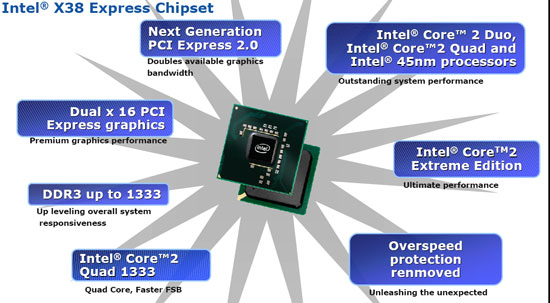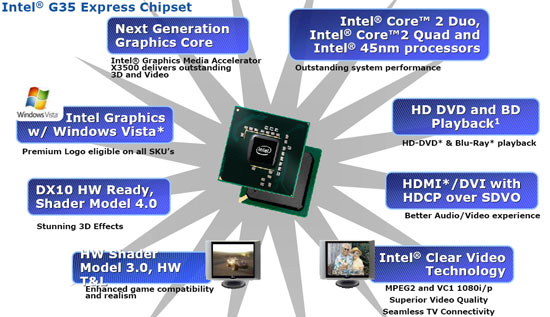Intel P35: Intel's Mainstream Chipset Grows Up
by Gary Key & Wesley Fink on May 21, 2007 3:45 PM EST- Posted in
- CPUs
X38 and G35 Chipsets - 3rd Quarter
While the X38 replacement for the 975X chipset will not launch until the 3rd quarter, Intel did provide enough information to make us wish it were here today. In addition to the feature enhancements on today's P35 chipset, X38 will add several unique features.
X38 will be the only Intel 3 series chipset to fully support dual x16 PCIe graphics. It was interesting that Intel did not specify CrossFire graphics in their literature, but we don't want to read too much into what wasn't said. The X38 will also be the first chipset to support PCI Express 2.0, which will replace the current PCIe standard. The other intriguing feature is something Intel calls "removing overspeed protection". This apparently refers to the fact X38 that will not have artificial bus speed limits on the chipset. We have seen what appeared to be artificial speed limits on Intel chipsets in the past, and an Intel chipset that can be pushed without artificial speed limits will be welcomed by all computer enthusiasts.
Other X38 features appear to be common to the P35 chipset, including full support for the 1333 processor bus and 1333 memory. X38 will also support all existing Intel processors and upcoming Penryn 45nm processors, just like other Intel Series 3 chipsets. X38 may also support other processor offerings, but Intel is not saying anything about that at this point.
G35
The third quarter will also see the introduction of Intel's G35 chipset, which will be Intel's most advanced integrated graphics chipset to date. While this may not be of huge interest to our readers, please keep in mind that the vast majority of computers sold today include integrated graphics. The G35 will be a very big deal for Intel and will be closely scrutinized by large-volume OEMs.

The G35 will be based on Intel's next-generation X3500 Graphics Media Accelerator. Full DX10 support is claimed, including support for Shader Model 4.0. For backwards compatibility X3500 also will support Shader Model 3.0 and Hardware Transform and Lighting (T&L). High Resolution DVD playback is also featured, with support for both HD-DVD and Blu-Ray playback. X3500 also is said to support HDMI and DVI. MPEG2 and VC1 1080i/p are also supported by the Intel Clear Video feature of X3500. Like the other series 3 chipsets, all current Intel processors are reported as well as future Penryn 45nm processors.
With DX10 support, all of the basic features are set in stone by Microsoft. That means that X3500 could actually be a true competitor on entry level configurations. Compared to previous Intel IGPs, X3500 certainly looks to bring some nice improvements to the platform, but we'll have to test actual performance and drivers before we can say for sure whether that's the case.










58 Comments
View All Comments
drewintheav - Sunday, May 27, 2007 - link
When you tested the P5K Deluxe Wifi mainboard and OCZ Reaper 9200 ddr2 memory were you able to boot up with with both modules of the reaper memory installed or did you have to boot up with a different memory and then adjust the ddr2 voltage to 2.3?I can not boot with all settings on the Asus P5K Deluxe Wifi set to default. The motherboard starts up but the screen stays black and there is no beep or POST information displayed.
Were you able to boot up no problem? I was able to boot no problem at default settings on my Asus Commando with the same OCZ Reaper 9200. Do you think I need to replace my motherboard? I also have had the pc spontaneously restart twice now.
Thanks in advance for any info or suggestions that you can provide.
Stele - Tuesday, May 22, 2007 - link
Most sites seem to list Asus's high-end boards as having 8-phase power, as per the spec sheet provided by Asus. However, I've a funny feeling that it might not be so, despite the number of MOSFET "sets" and inductors. When I was working on P5B Deluxe boards, which also supposedly sports 8-phase power, I noticed that they used the Analog Devices ADP3198 synchronous buck controller. This controller supports up to 4 phases max, which suggests that the 8 apparent phases are actually arranged in two sets of 4-phase circuitry running in parallel. If this is true, it's an unfortunate bit of misleading marketing, though it was probably due to the pressure in keeping up with gimmicky competitors touting quantity (6-phase, 12-phase, xx-phase) over quality (component/circuitry design/implementation).The presence of a 'voltage damper' setting in BIOS for the P5Ks seem to hint at the possibility of something new, however: either the presence a new PWM controller or some additional droop compensation circuitry. I'm guessing it's still an ADP3198, and hence the latter scenario. Would it be possible to find out what controller's being used on the P5K, pretty please? :P
IMHO, while the Analog PWM controllers have generally been stellar performers in their own right, they ought to start improving their products so that manufacturers would have to worry less about breaking relationships with them and jump ship - especially with, for example, Intersil having excellent analog (up to 6 phases) and digital PWM controllers.
Stele - Wednesday, May 23, 2007 - link
Now that I recall, Gigabyte too is in the habit of being rather liberal with how they count phases... in fact they're arguably one of the first to do so, along with their DPS gimmick in the 875 days. The DQ6 is listed and marketed has having 12 phases, but if I remember correctly, Gigabyte uses an Intersil ISL6327 for their 12-phase products (at least the GA-965P-DQ6 did so). This is a 6-phase controller, which means that, as in the case of the Asus designs mentioned above, the "12-phase" power claimed by Gigabyte is little more than two sets of 6 phases in parallel. Is this still the case in the P35-DQ6?If so, it'd be good to point out the reality under misleading hype, so that if nothing else, readers and potential buyers are better informed - and to underscore the fact that there are hardware sites who do know their stuff and who don't simply swallow and parrot whatever the manufacturers throw at them.
Just my 2 cents'!
shabby - Monday, May 21, 2007 - link
The loop-de-loop kicks ass on the msi board :DTA152H - Monday, May 21, 2007 - link
I agree, I don't know why, but I need it!Gary Key - Tuesday, May 22, 2007 - link
It actually works also, a lot less aluminum than the Gigabyte and ASUS solutions, yet the MCH/PWM area seemed to be within 1C of the other boards in our early testing with the Quad. Still not a big fan of the "designs" coming out but to each his own. I think the new abit P35 board as the best looking heatpipe system but then I like it old school... :)TA152H - Wednesday, May 23, 2007 - link
I don't like you any more. I'm just not sure I can relate to someone that didn't like that rollercoaster :P .I expect it probably should work pretty well. With windmills, one of the biggest considerations for the power it produces is how tall the tower is; the further from the Earth, the more wind energy it will get. So, by extension, by creating this roller coast they elevate it to a higher point, and of course by convection the hottest air will hit that spot. So, it should work out pretty well (by now you're probably scratching your head thinking "what is this idiot talking about". It's because I have no clue, but I want it, and I'm making stuff up to validate the decision like this windmill nonsense).
Old school heat pipe systems? Hmmmm, I don't remember even seeing a heatsink on anything earlier than a 486 processor, so I just think we can categorize your heatsink taste, at best as prosaic, and maybe even boring! I think this roller coaster only portends of things to come, I expect bigger ones soon, as well a hot dog stand. Motherboards seem to have become amusement parks, we have carousels (spinning fans), water equipment, towers, and now a roller coaster. Good grief.
yyrkoon - Thursday, May 24, 2007 - link
Oh, and . . . .http://www2.abit.com.tw/page/en/motherboard/mother...">http://www2.abit.com.tw/page/en/motherb...pMODEL_N...
yyrkoon - Thursday, May 24, 2007 - link
I agree with Gary, these 'windmill' and butt ugly other heatpipes from other OEMs can not touch ABITs OTES in looks. I guess that is what hapens when you pioneer a technology, and everyone copies . . .Stele - Monday, May 21, 2007 - link
While the addition of 2 more USB 2.0 ports is certainly one of ICH9's new features, doesn't ICH8 already offer 6 SATA ports? That was one of the latter's welcome improvements over the ICH7.
There also doesn't seem to be anything in the block diagrams that indicate the presence of an eSATA port. I'm guessing here, but could it be that the mention of a "port multiplier" led to some confusion? After all, the 6 SATA ports in ICH8 and 9 are actually controlled by two host controllers, with internal port multipliers that connect them to 4 and 2 ports respectively (that's why, for example, some board manufacturers label two of the SATA ports as 'secondary' and state that it is generally not advisable to connect the boot drive to them).
However, I'm guessing that the port multiplier issue came up in the context of ICH9 because apparently Intel would be using only command-based switching in ICH9's port multipliers, removing FIS (Frame Information Structure)-based switching apparently used in ICH8 (most port multipliers use both command-based and FIS-based). While FIS-based switching offers higher performance under multiple-drive loads than command-based switching, FIS-based switching is more complex and hence expensive to implement; besides that, it uses slightly more CPU resources to manage the increased command and data flow rate. As such, Intel might have chosen to use the simpler, cheaper command-based switching for ICH9. If this is true, it might be to keep costs down and because many hardware sites probably over-emphasised on CPU-utilisation when comparing SATA performance with other chipsets. Argh. Again, this was something that came up on the grapevine but I've not been able to find official sources that verify or deny this... perhaps Anandtech could shed some light?
In the event that it's true, exactly how much performance would suffer under multiple-drive read/write loads is unclear, and this is where an extensive non-RAID and RAID performance test with perhaps a full six drives (or even 3/4/5) might give some hint. On the other hand, it may be that performance would not differ much in scenarios short of an array larger than a two-drive RAID 0/1 (as demonstrated in this review), so Intel decided to dispense with what they may consider a needless luxury.